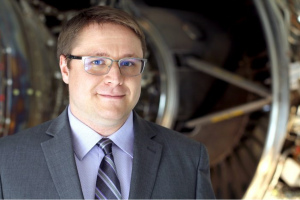Presented By: Aerospace Engineering
Chair's Distinguished Lecture - Incorporating SLAM Methods and Error Correction for Accurate, Scalable Autonomous Assembly of Space Structures
Erik Komendera, Ph.D., Virginia Polytechnic Institute and State University

Erik Komendera, Ph.D., Virginia Polytechnic Institute and State University
In the field, autonomous structure assembly is an unsolved problem dominated by uncertainty in the agents, components, sensors, and environment. Inadequate solutions to this problem have prevented the practical adoption of autonomous assembly in the field, which would enable improvements in safety, reduction in costs, and more ambitious concepts such as large space telescopes. Accurate state estimation, and a capacity to correct errors, will be crucial to enabling practical field assembly, especially for structures such as space telescopes that require sub-mm accuracy over tens of meters. Uncorrected assembly experiences polynomial error growth stemming from sources including tolerances and manufacturing errors. By modeling structure assembly as a Bayesian process, estimation methods can be applied to the assembly graph to improve accuracy. In recent research, Dr. Komendera has developed an approach that adapts Simultaneous Localization and Mapping methods and local error correction onto an evolving assembly workspace modeled as a dynamic Bayesian network. This approach enables accurate, scalable, parallelizable construction without assuming perfect sensors or requiring a global measurement system. This talk will describe the mathematical foundations of the assembly algorithm, its expected performance on backbone trusses and space telescope models, validation through hardware trials, and future research directions.
About the speaker...
Dr. Erik Komendera is Assistant Professor of Mechanical Engineering at Virginia Tech, and director of the Autonomous Field and Space Robotics Laboratory. His research focuses on autonomous multi-agent construction on Earth, on orbit, and on the surfaces of other worlds, with an emphasis on robust algorithms to detect, classify, and repair failures during and after the assembly process. His current projects include a collaboration with NASA to develop robots and algorithms for constructing lunar habitats and on-orbit persistent platforms. He also works with industry to improve methods for autonomous assembly of variable components. He is also a member of the in-Space Assembled Telescope (iSAT) study team that will recommend an approach to assembling a space telescope. From 2014-2018, Dr. Komendera was a robotics researcher at NASA Langley Research Center in Hampton, VA. He earned his MS ('12) and PhD ('14) in Computer Science from the University of Colorado, and a BSE in Aerospace Engineering ('07) from the University of Michigan. At NASA, he served as assembly robot task lead on the project titled “Commercial Infrastructure for Robotic Assembly and Servicing” (CIRAS). In addition, he was the Principal Investigator for a Langley IRAD project to investigate methods for assembling solar arrays.
In the field, autonomous structure assembly is an unsolved problem dominated by uncertainty in the agents, components, sensors, and environment. Inadequate solutions to this problem have prevented the practical adoption of autonomous assembly in the field, which would enable improvements in safety, reduction in costs, and more ambitious concepts such as large space telescopes. Accurate state estimation, and a capacity to correct errors, will be crucial to enabling practical field assembly, especially for structures such as space telescopes that require sub-mm accuracy over tens of meters. Uncorrected assembly experiences polynomial error growth stemming from sources including tolerances and manufacturing errors. By modeling structure assembly as a Bayesian process, estimation methods can be applied to the assembly graph to improve accuracy. In recent research, Dr. Komendera has developed an approach that adapts Simultaneous Localization and Mapping methods and local error correction onto an evolving assembly workspace modeled as a dynamic Bayesian network. This approach enables accurate, scalable, parallelizable construction without assuming perfect sensors or requiring a global measurement system. This talk will describe the mathematical foundations of the assembly algorithm, its expected performance on backbone trusses and space telescope models, validation through hardware trials, and future research directions.
About the speaker...
Dr. Erik Komendera is Assistant Professor of Mechanical Engineering at Virginia Tech, and director of the Autonomous Field and Space Robotics Laboratory. His research focuses on autonomous multi-agent construction on Earth, on orbit, and on the surfaces of other worlds, with an emphasis on robust algorithms to detect, classify, and repair failures during and after the assembly process. His current projects include a collaboration with NASA to develop robots and algorithms for constructing lunar habitats and on-orbit persistent platforms. He also works with industry to improve methods for autonomous assembly of variable components. He is also a member of the in-Space Assembled Telescope (iSAT) study team that will recommend an approach to assembling a space telescope. From 2014-2018, Dr. Komendera was a robotics researcher at NASA Langley Research Center in Hampton, VA. He earned his MS ('12) and PhD ('14) in Computer Science from the University of Colorado, and a BSE in Aerospace Engineering ('07) from the University of Michigan. At NASA, he served as assembly robot task lead on the project titled “Commercial Infrastructure for Robotic Assembly and Servicing” (CIRAS). In addition, he was the Principal Investigator for a Langley IRAD project to investigate methods for assembling solar arrays.